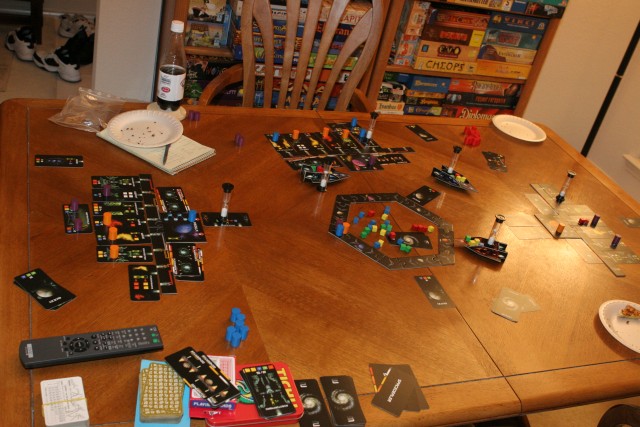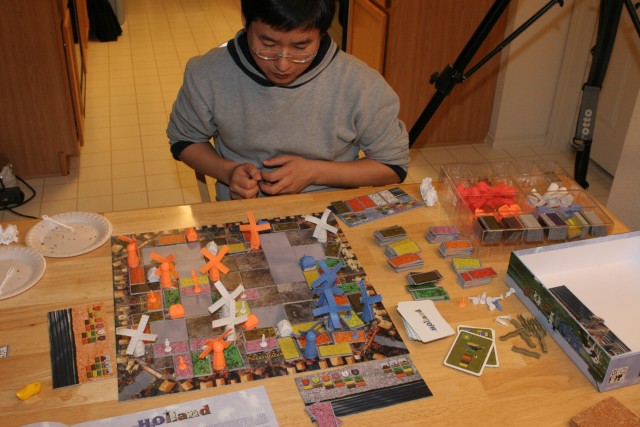
John was definitely wanting to hose me tonight. I had wanted to play H2olland for a while now. And yet when I suggested it for a game, John instead recommended Tara, Seat of Kings. Doug was accommodating and was willing to play either. So we settled on a game that all of us had played before: Space Dealer. This time we played with the Gizi cards (victory points for the neutral planets). As I play this game more, I loose the sense of being rushed for time. Next time, I want to play with the advanced cards. Or even with eight people…

Peter and Francesca helped me out by playing H2olland. And I was glad I did play it. Not only was it an interesting and thematic game. But, based on the comments I was hearing from the other table, Tara was sounding suspicious.
H2olland is ultimately about planting tulips and then scoring them. But, before that is done, land must be reclaimed from the sea with windmills. There are six species of tulips with victory points ranging from 1 to 6. The level of tulips that you can buy is determined by how many windmills that you have on the board. You get tulips either by purchasing them by trading supplies at the co-op. Or as a reward for reclaiming land from the sea. Tulips are planted much like crops. However, they don’t really do anything during this phase of the game. You do get a worker that is placed on top of the field. These workers tend the tulip fields and will get you victory points during the second half of the game.
You start out with one of each type of resource: beans, carrots, corn, cows, and potatoes. These are placed out on the board during spring time next to your farm houses or your windmills. The crops are harvested during autumn. A weather card is revealed that determines what crops are harvested and other events that may happen (floods, droughts, disease, shortages, or surpluses). If a crop is touched by at least one of your windmills or farm houses, then you get one of the matching tiles from the co-op. So players will want to either touch other’s crops or try and block other player’s from touching their crops. You can buy more farm houses, windmills, dikes, or tulip fields from the co-op during this phase. And you can only store 5 crops/tulips through to spring.
During summertime, the land is reclaimed from the sea. One windmill can only pump out one tile of sea. If there are more tiles of sea than there are windmills, then nothing happens. So, players will place dikes out in order to cut off the excess sea tiles and to allow the windmills to pump out the water. One interesting aspect of this is that there can be more windmills that can pump out a tile than are needed. Only one is used and ties are broken by the start player. So it is possible to steal the glory of pumping out a tile and getting the tulip tile reward for yourself.
The game enters its second phase after the lake has been fully drained or six years. First, we remove all of the crop fields that are connected by at least two or more players. Next, players are allowed to place any remaining farm houses, windmills, or tulip fields. Then, all of the workers are removed from the tulip fields.
Now, the race is on to claim tulip fields. In player order, you are allowed to place one worker on a field that is next to either your farm house, your windmill, or another field that is already claimed by you. So, your goal is to claim the most expensive fields and also to cut off other players from being able to claim fields.
All in all it was an interesting game. And it is one that I should have played sooner.
